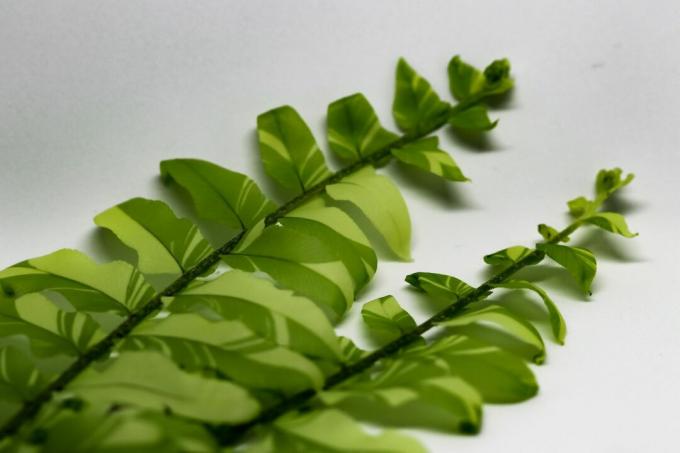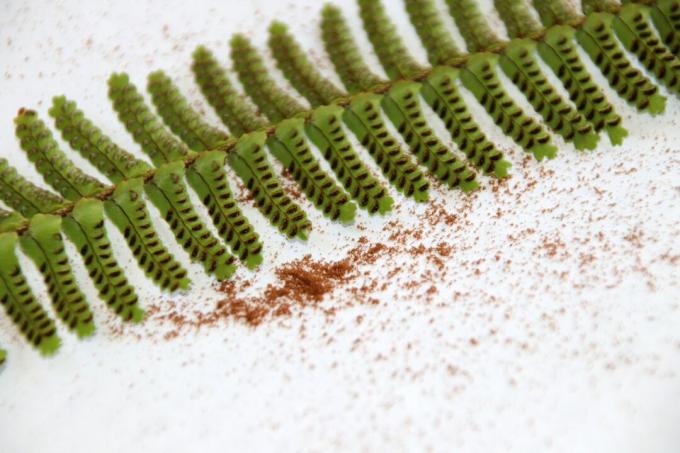The sword fern is not only easy to care for, it is also an interesting prehistoric plant and an eye-catcher in the home and office.

Here's how to find an appropriate location for the sword fern (Nephrodlepis) and get tips and tricks on the care and propagation of the tropical plant. We also present the most popular sword fern species and varieties.
contents
- Sword fern: origin and characteristics
- The most beautiful species and varieties
- Planting sword fern: location, soil and procedure
-
Care of the sword fern
- Water, cut and fertilize
- Sword fern is losing leaves: you can do that
- Propagate sword fern
- Is the sword fern poisonous?
Sword fern: origin and characteristics
The sword fern is also often referred to as kidney scale fern, ruffled fern, or simply a fern. With its green fronds, the sword fern brings the character of the jungle into the apartment. It is a genus of plants within the sword fern family (Nephrolepida). There is still disagreement about the number of species, which is estimated at around 30. The sword ferns grow in tropical and subtropical forests either on the ground or epiphytic, that is, perched on other plants. The evergreen perennials have pinnate leaf fronds that grow in rosettes from the center of the plant. They usually hang over the edge of the pot, which is why the sword fern is particularly effective when hanging in a hanging basket.
The sword fern is also said to have an air-purifying effect, which makes it all the more popular as a houseplant.

by the way: Ferns are among the oldest plants on our planet. They settled the country over 300 million years ago. They do not form flowers, but use spores that are located on the underside of the leaves to reproduce.
The most beautiful species and varieties
The genus of sword ferns includes various species, as well as sword fern varieties specially bred for housekeeping. Here we give a small overview of the most popular representatives of the sword ferns.
- Nephrolepis exaltata: The classic among sword ferns. When one speaks of the sword fern, it is usually from Nephrolepis exaltata the speech. The overhanging fronds grow slightly upright and are compound or pinnate. They can reach a length of 80 cm.
- Nephrolepis cordifolia: This species likes shady and moist locations and is also a popular houseplant. The slightly upright fronds are a bit narrower here and reach lengths of about 60 cm. In contrast to Nephrolepis exaltata forms Nephrolepis cordifolia underground tubers.
- Nephrolepis exaltata ‘Fluffy Ruffles’: This is a miniature variety with leaves that are divided into two parts. This means that the individual leaflets of the fronds are subdivided again. This results in the "fluffy" appearance.
- Nephrolepis exaltata ‘GreenLady': This variety convinces with a bushy, dense growth and a medium green leaf color.
- "Variegata": In contrast to the other varieties, the leaves of this heavy fern variety are not completely green, but variegated green, light green and white.

Planting sword fern: location, soil and procedure
The ideal location for heavy ferns is humid, warm and partially shaded to light, but not sunny, especially at noon. Since the sword fern grows in nature under the protection of other plants, it should never be exposed to the blazing sun in the room. Still, it needs some light for healthy growth. The temperature should be around 20 ° C all year round and not drop below 18 ° C. Since the sword fern loves moist air, it should not be placed near a draughty window or over a heater, if possible. The sword fern finds good conditions in the bathroom, when enough light can penetrate there. If you want to keep the sword fern in the bedroom or another place in the apartment, you have to keep the humidity high by occasionally spraying the plant. The attitude in Hydroponics is possible, the humidity in the immediate vicinity of the fern is also automatically increased somewhat.

Above all, the substrate for the sword fern must have a high water storage capacity. A loose structure is also an advantage. For example, a sustainable choice is ours Plantura organic universal soil. It consists of natural raw materials and does not contain peat. To prevent waterlogging, a drainage layer made of potsherds or a similar, coarse material should be laid on the bottom of the pot.
In the summer months, the sword fern can also be put outside. Here, too, you should choose a location protected from the sun and slowly get used to the new location. So put it outside for a few hours for the first few days and gradually longer and longer. The sword fern should be brought back into the house from September. To increase the humidity, you can fill the trivet with expanded clay balls and pour water on it. If you now place the pot on the balls, the sword fern with the roots is not in the water, but still benefits from the moisture that evaporates.
Care of the sword fern
In addition to a suitable location, the sword fern needs care so that it can develop splendidly. This includes, above all, regular watering and fertilizing.

Water, cut and fertilize
The moisture-loving sword fern should be watered regularly - but not excessively. He likes a constantly moist root environment, but not waterlogging. Therefore remove the excess irrigation water that collects in the coaster. Ideally, use lukewarm rainwater or other lime-free water. Stale tap water can also be used. The water for spraying the fronds should also contain no lime if possible.
You don't have to cut the sword fern, but you can remove dried, yellow or too long leaves. Cut this off at the base with a sharp knife. The sword fern can stand a cut and sprout again.
If you fertilize the sword fern, it will grow green and lush when dosed appropriately. In the growing season from spring to autumn you can give the plant a green plant fertilizer every two weeks via the irrigation water. For example, ours is suitable for this Plantura organic indoor & green plant fertilizer, which provides nitrogen and potassium in the right proportions for lush ornamental foliage plants. In the case of sword fern, a half dose of fertilizer is sufficient. After repotting, you do not need to fertilize for the first three months. You can do without fertilizer even in winter.
Is sword fern hardy?
The sword fern is not hardy outdoors in our country because it needs relatively high temperatures even in the cold season. A room temperature of over 12 ° C is necessary for the sword fern to continue doing well. Nevertheless, the sword fern grows more slowly in winter, which is why it needs less fertilizer at this time.
You can repot the sword fern in spring. Young specimens are best every year, older ones only every three years, or when the root ball completely fills the pot. Use a larger pot and do not fertilize for the first few months after repotting.

Sword fern is losing leaves: you can do that
The sword fern gets withered and brown leaves or even loses its fronds? There can be different reasons. As soon as you have identified the reason, there is an opportunity to save the sword fern.
- Dry air: It is often not that easy to keep the humidity adequately high. Then it can happen that the fronds dry up and turn brown. Place a bowl of water next to the plant and spray the fern with lime-free water every few days.
- Dry earth: Even dry earth can lead to withered fronds, as water can no longer be transported from the roots into the leaves. Use a finger test to check whether the soil is still moist enough and water more often if necessary.
- Direct sun: Since ferns are used to shady or partially shaded places, too much light can lead to brown discolored leaves. Then simply move the sword fern to a less bright spot.
- fertilizer: Too much or too little fertilizer can also cause leaf discoloration. Therefore, make sure not to dose the fertilizer too high and try to fertilize a little less at first.

Propagate sword fern
There are several methods of propagating the sword fern. In addition to dividing the mother plant and using offshoots, you can also try propagating via spores.
The easiest way to reproduce is by dividing the root ball. When repotting the sword fern, you can simply split the root ball into two parts and plant the two plants in separate pots. However, this method only works with older plants that already have several leaf rosettes.
Propagation via sword fern offshoots is also possible in older specimens. These form small runners out of the root ball, which in turn can be separated and planted in their own pots. Keep the young plants moist and ensure there is sufficient humidity.

Propagation via the spores is not that easy, but it can be successful. When the spore capsules on the underside of the leaf are brown and ripe, you can cut off one of the fern fronds and place it on a piece of newspaper. After a while, the capsules should open and the spores should fall on the newspaper. You must now carefully distribute this on the growing substrate. Our example is suitable for this Plantura organic herb and seed compostwhose properties are precisely tailored to the needs of young plants. Spray the spores with water and cover everything with plastic wrap. This can be aired every few days. The vessel is best placed in a warm place. Over time, a mossy coating should form. This must be carefully placed on new substrate with the help of a spoon and placed in a bright place. With a little luck, small sword ferns will form here in a few weeks. Make sure to always use clean tools and sterile, boiled water.

Is the sword fern poisonous?
Sword ferns are mildly poisonous, so they contain poisonous substances in such small quantities that consumption of the fronds is considered harmless. According to this, the sword fern is not toxic to cats, dogs or other pets and you don't have to worry about your children either.
Another interesting fern for house keeping is the Nest fern. You can find out what makes it special and how to care for it in our article.
